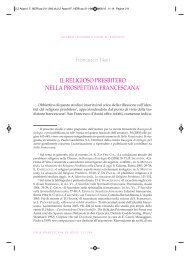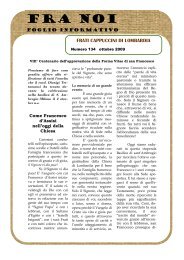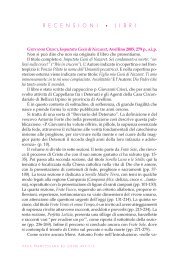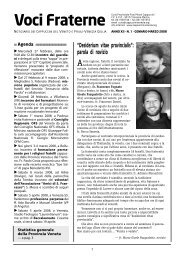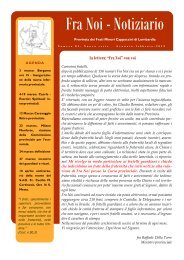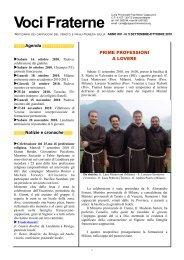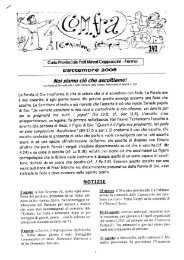KUSTER N. – KREIDLER-KOS M., La pala di Santa ... - go to site
KUSTER N. – KREIDLER-KOS M., La pala di Santa ... - go to site
KUSTER N. – KREIDLER-KOS M., La pala di Santa ... - go to site
- No tags were found...
You also want an ePaper? Increase the reach of your titles
YUMPU automatically turns print PDFs into web optimized ePapers that Google loves.
404NIKLAUS <strong>KUSTER</strong> - MARTINA <strong>KREIDLER</strong>-<strong>KOS</strong>ta <strong>di</strong>pinte sopra il reliquiario della santa ebbero una funzione essenzialmente<strong>di</strong>dattica e cioè segnatamente per i penitenti e le penitenti del TerzoOr<strong>di</strong>ne che vivevano presso la chiesa della santa in Cor<strong>to</strong>na 15 . Da ciò,secondo la Cannon, deriva un cambiamen<strong>to</strong> degno <strong>di</strong> nota nell’utilizzo <strong>di</strong>tali retabli: «In the years around 1300 a vita panel could clearly serve <strong>to</strong> instructits au<strong>di</strong>ence about an exemplary life of penitence and prayer» 16 .Analogamente come nelle tavole <strong>di</strong> Maddalena e Margherita, anchenella tavola <strong>di</strong> Chiara <strong>di</strong> Assisi colpisce la scelta particolare delle scene <strong>di</strong>vita che par<strong>to</strong>no dalla «conversio» <strong>di</strong> una giovane donna fino ad arrivarealla morte <strong>di</strong> una santa e rinunciano in modo sorprendente a miracoli <strong>di</strong>guarigione. <strong>La</strong> Cannon ipotizza quin<strong>di</strong>, anche nel caso <strong>di</strong> Chiara, unafunzione primaria <strong>di</strong>dattico-parenetica per una precisa cerchia <strong>di</strong> destinatari17 . Come Niklaus Kuster, ella segue la tesi <strong>di</strong> Elvio Lunghi, secondocui <strong>di</strong>etro il committente sono da supporre «prominent men from outside thecloister» e conclude allo stesso modo che si tratti del Vescovo Simone.Anche lei trova «meno convincente» la supposizione <strong>di</strong> Jeryldene Woodper cui il Papa Martino IV, menziona<strong>to</strong> nella datazione della immagine,potrebbe aver commissiona<strong>to</strong> la tavola 18 . Le monache a sten<strong>to</strong> ven<strong>go</strong>noprese in considerazione come possibili destinatarie della tavola <strong>di</strong> Chiara,dal momen<strong>to</strong> che dalla loro clausura non potevano vedere, o la vedevanosolo a fatica, la <strong>pala</strong> dell’altare. È mol<strong>to</strong> più probabile che la tavolaparlasse da sé nella navata della chiesa: la Cannon ritiene chethe principial au<strong>di</strong>ence for the <strong>Santa</strong> Chiara panel must have been the friarswho officiated in the church and the visi<strong>to</strong>rs <strong>–</strong> both religious and lay, pilgrims andlocal residents <strong>–</strong> who vi<strong>site</strong>d it. As in the case of the Margherita panel, the main15J. CANNON, Beyond the Limitations of Visual Typology, 299: «The specta<strong>to</strong>r is thus also led<strong>to</strong> hope that by putting on the habit of the Third Order, and by following its spiritual program, heor she may ultimately come <strong>to</strong> para<strong>di</strong>se. The tertiaries would have had many opportunities <strong>to</strong> considercarefully a painting in their local church, as they were encouraged <strong>to</strong> attend on a daily basis».16J. CANNON, Beyond the Limitations of Visual Typology, 295-302.17Le classiche funzioni <strong>di</strong> tali tavole d’altare che derivano dall’arte francescana ven<strong>go</strong>nodescritte come segue: «A vita panel could also commemorate the appearance and, in certainsenses, the presence of a holy person. This presence might by located in the past, the present,or, indeed, in the future…images of Saint Francis might commemorate a visit made by the saint atsome time in the past <strong>to</strong> the church in question. The image could also denote the presence of a saintas an intercessor, as an permanent heavenly advocate from whom help might be requested now orin the future…Initially such panels (for example, those of saint Francis) served <strong>to</strong> commemorateor stand for an absent body rather than the presence of a body. In the case of the <strong>Santa</strong> Chiara panel,the body was hidden away, buried below the high altar of the church de<strong>di</strong>cated <strong>to</strong> the saint» (J.CANNON, Beyond the Limitations of Visual Typology, 293).18J. WOOD, Women, Art and Spirituality, 31,58.



